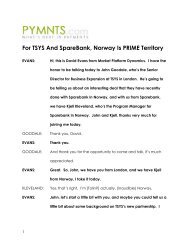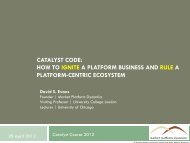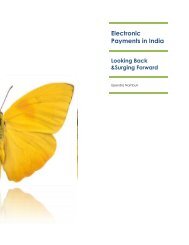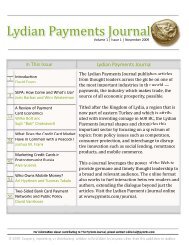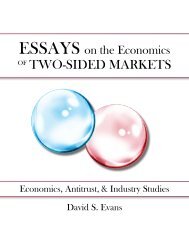Interchange Fees: The Economics and Regulations of What
Interchange Fees: The Economics and Regulations of What
Interchange Fees: The Economics and Regulations of What
- No tags were found...
You also want an ePaper? Increase the reach of your titles
YUMPU automatically turns print PDFs into web optimized ePapers that Google loves.
40 INTERCHANGE FEEScompleted. Without additional empirical work, the Fed Economists concluded that regulation wasrisky: “[T]he possible effects <strong>of</strong> any intervention are highly uncertain. Although economic modelscan provide some insights regarding the qualitative effects <strong>of</strong> a policy intervention, they typicallyhave little to say about the quantitative magnitudes <strong>of</strong> these effects.” 20We are not aware <strong>of</strong> any empirical analysis showing that the efficient interchange fee is belowthe market-determined rate, let alone substantially below. In what follows we briefly discusssome recent theoretical work that seems broadly consistent with Dr. Prager’s answer to ChairmanBernanke concerning the possible market failure. This work, which is based on a number <strong>of</strong> assumptions,suggests that the efficient rate may be equal to or below the market-set rate but thatthe gap, if any, is likely to be small. In light <strong>of</strong> all this, market-set interchange fees seem reasonablegiven the current state <strong>of</strong> knowledge, <strong>and</strong>, as costs vary substantially among issuers, they are morereasonable <strong>and</strong> no less “reasonable <strong>and</strong> proportional to cost” than the safe harbor <strong>and</strong> ceiling proposedby the Board.E. Organization <strong>of</strong> This Report<strong>The</strong> remainder <strong>of</strong> this report has six sections that present the basis for the conclusions summarizedabove.Section II examines the likelihood that the proposed regulation will harm consumers, contraryto the intent <strong>of</strong> Dodd-Frank.Section III considers the overall economic impact <strong>of</strong> the recent growth in debit card usage <strong>and</strong>concludes that this is a story <strong>of</strong> market success, not market failure.Section IV shows in more detail that the Board has not identified a market failure that its proposedregulation is designed to correct.Section V demonstrates that the proposed regulation is not justified by any <strong>of</strong> the possiblemarket failures discussed in the theoretical literature.Section VI considers the implications <strong>of</strong> some recent theoretical work for the empirical research<strong>and</strong> analysis the Board needs to do in order to estimate the gap, if any, between socially efficient<strong>and</strong> market-set interchange fees. We argue both that it is possible to estimate this gap <strong>and</strong> that thegap is most likely small, perhaps small enough, in light <strong>of</strong> the inevitable costs <strong>of</strong> price regulation,to justify a finding that market-set fees are reasonable <strong>and</strong> proportional to cost.Section VII considers what the Board should do now to meet its statutory deadline in theabsence <strong>of</strong> an estimate <strong>of</strong> the difference between market-set <strong>and</strong> socially-efficient interchange fees.We argue, as above, that the Board should avoid what may well prove to be unjustified disruption<strong>of</strong> an industry that has served consumers well <strong>and</strong> should, therefore, require, at most, a small reductionin interchange fees.20<strong>The</strong> Fed Economists (2009), at p. 42.



